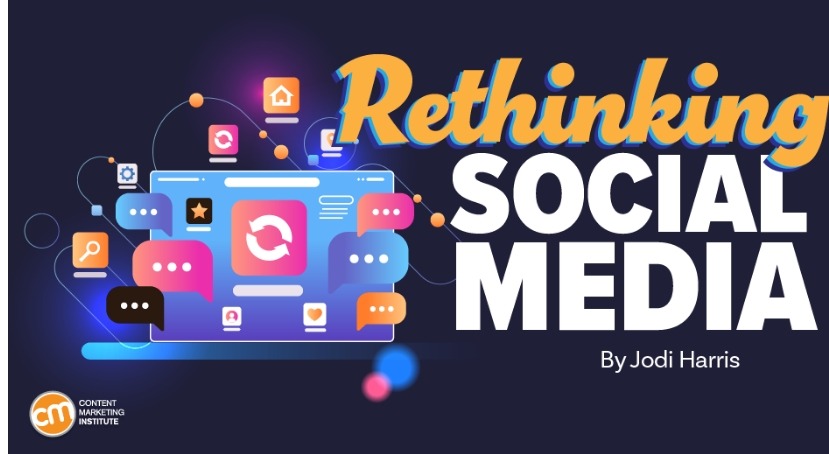Gone are the days when social platforms sent significant traffic to publisher and brand websites. Today, platforms want to keep eyeballs and engagement within their digital walls.
Then there are the near-constant changes to algorithms affecting organic reach, lawsuits alleging the major social platforms cause societal harm, potential costs for participating, and the possibility that the hot new platform everyone’s buzzing about might become yesterday’s news in no time.
You may start to question whether it makes sense to invest your finite resources (time, budget, creativity, energy) on social media at all. And you wouldn’t be alone.
Michael Brenner, CEO of Marketing Insider Group, recommends that their clients spend less time and budget on social. “Our research tells us social media only generates 2% of traffic and leads for most companies, and paid social is only 2%,” he says. “Focus your effort where the people are willing and ready to engage.”
Considering the current state of social, it’s a good time to take stock of what your content program stands to gain from this channel. These suggestions will help you decide on which platforms to spend resources (if any) and how to get the most out of your invested resources.
Experiment and diversify, but exercise caution
Because social media sites exist to make money for their parent companies (not your brand), the benefits of participating will remain volatile, says Adrienne Sheares, owner of ViviMae Labs. To mitigate the risks, she recommends you establish a strategy for investing in owned platforms (e.g., your blog, website, or email newsletters) where you have more control over what happens.
The goal, says LetterShop x KMC CMO Karen McFarlane, is to ensure the flow of communication between you and your audience, even if some members stray from a given channel.
Maintaining investment in channels your brand owns and operates, such as your website, blog, and email list, lets you stay in contact with your customers no matter which way the social media winds may blow, Karen says.
Align social strategy with audience and goals
If you decide to continue investing in social channels, remember that not every platform will serve your brand’s needs and goals. To track down your best opportunities, let your audience be your guiding star.
Social-listening tools and audience research can help you determine where they engage in conversations relevant to your brand, says Jill Roberson, vice president of digital marketing at Velir.
Similarly, keep an eye on the volume and quality of users engaging in your brand’s conversations. “If you see engagement is dwindling on a particular channel, it’s time to diversify and focus on expanding reach via the channels your audience prefers,” Jill says.
For example, the Pew Research Center found that 60% of users have taken breaks from X (formerly Twitter) in the past year. So, it’s no surprise that CMI’s latest research found that 32% of B2B marketers decreased their X use (and 20% decreased their Facebook use) over the last year.
If you’re pulling back on one platform and increasing participation in another, first examine the terrain of your preferred destination. Evaluate its conversation formats, audience makeup, and community standards against your content strategy to determine if it’s worth building – or sustaining – a presence.
That consideration includes understanding how each platform determines what content will appear in user feeds and notifications.
LinkedIn remains at the top of most B2B marketers’ social media lists. The same CMI research found that 84% of B2B marketers say LinkedIn delivers the best value compared with other social platforms. If you participate, optimize for the LinkedIn platform. For example, this Sprout Social experiment shows that LinkedIn social posts without links outperform those with links.
Daisy Shevlin, SEO and content manager at Kaspr, suggests customizing your content strategy to the particulars of each platform to keep people engaged as long as possible.
Think quality and originality over quantity
It’s easy for your content to get lost in the conversational stream. Focus on quality and originality (rather than quantity) to stand out, says Paul Fairbrother, owner of The Fairbrother Agency. “Leading the conversation with original insights, thought leadership, and ideas has never been so important,” he says.
To increase audience interaction, use your social content as a testing ground for ideas and unique perspectives on relevant issues. You can also share successful solutions to challenges your audience may face.
Sharing lessons learned has been a critical component in Kaspr’s approach to LinkedIn, Daisy says. Posting content about common pain points for their ideal customer profiles, such as tips for cold calling, helped the company grow its followers by over 200%.
But AdRoll senior content marketing manager Shae Henrie says social media conversations don’t have to be all business. “It doesn’t have to be boring. Creative, unique, and funny approaches are memorable and more impactful,” she says…Read More

